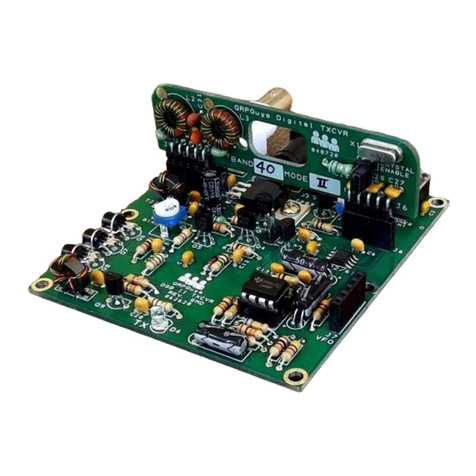
Note: While testing for operation, you can temporarily plug some earbuds into J3 MIC (OUT). This
is the audio out to your computer or tablet. If the particular band is open, you should hear received
signal tones in one of the earbuds. If you are not hearing any signals, determine the cause and
correct before continuing.
[ ] You should start to see signals. Adjust the Sound card input level and the V2 audio output level to
appropriate settings for your conditions.
[ ] Replace the antenna with a 50 ohm dummy load.
[ ] Set the sound card output level to minimum.
[ ] Activate “TUNE” on the WSJT-X to manually transmit.
[ ] Increase sound card output level until the board switches into Transmit. (RED LED goes on) you
can continue to increase the output level a little bit to ensure reliable triggering of the VOX circuit.
[ ] Press “TUNE” again to stop the manual transmitting mode.
If you have a watt meter in line with the antenna, you will notice the power will
continue to increase as the audio input continues to increase. Do not do this. The
apparent increase in power is due to overloading the mixer and amplifier stages,
putting them into a non-linear region.
If you look at the RF output with an Oscilloscope, it should look like a string of pearls. This is the
result of the two side bands mixing. Increasing the drive will turn the string of pearls into more of a
picket fence and then approach being a wall. This is the result of the amplifier stages saturating
resulting in the signal flat topping. At this point your creating spurious outputs to the annoyance of
others in the band. Keep it clean. It's bad enough we're transmitting two side bands.
[ ] Reconnect your antenna and you are good to go.
Refer to the WSJT-X documentation and our website links for the details on operation.
Theory of operation:
The F8 DSB transceiver is built around the ubiquitous SA602/612A mixer-oscillator chip. It provides both the
receive and transmit functions.
Receiver:
The antenna is first routed through the transmitter's Low Pass Filter (LPF) and then into the T/R relay. The
received signal is bottom coupled into the tuned circuit comprised of L1 and C26. C26 is actually the stray
capacitance of the band module and SIP connectors. Although this does not peak L1 at exactly the desired input
frequency, it's close enough as the single L/C tank circuit is pretty broad.
The received input signal is mixed with the internal oscillator, to produce the base line audio output. The audio
output is coupled to a high gain audio amplifier through two 0.1 ufd caps (C15+C13) in series. The MOSFET
Q5 is connected to the common point of C15 and C13 provides audio muting during transmit by shunting the
junction to ground.
U2b, one half of a LM358 op amp, provides audio gain for decent sensitivity. A non-inverting configuration is
used so that the input can be high impedance, allowing for reasonably small value input coupling caps. The gain
is set to 47. The amplifier then drives an audio level pot so the audio level can be adjusted to a level suitable for
your PC sound card.
Page 9 of 13 digital_txcvr_assembly_030720.pdf




























